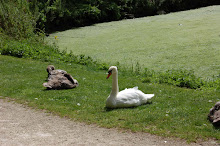 . . . the leaves have just begun to turn, and the trees are a blaze of variegated greens, yellows and reds.
. . . the leaves have just begun to turn, and the trees are a blaze of variegated greens, yellows and reds.







 I was somehow taken by these red berries against the green rubbish bin (!)
I was somehow taken by these red berries against the green rubbish bin (!)
 Near the junction of Nunhead Lane and Consort Rd there is this magnificent bay tree (? or so I'm told it is):-
Near the junction of Nunhead Lane and Consort Rd there is this magnificent bay tree (? or so I'm told it is):-
 On the corner, and along towards the green, it still seems quite summer-y. . .
On the corner, and along towards the green, it still seems quite summer-y. . .
 I was also quite taken by this tree leaning (not, as it appears from this angle, against a house) on Scylla Rd.
I was also quite taken by this tree leaning (not, as it appears from this angle, against a house) on Scylla Rd.
 Nunhead seems to be slowly losing pubs. In the last few years several have closed and the other week there was a for sale sign outside the Old Nun's Head. The Rye Hotel gastropub, however, was very busy today. Parked outside the pub were a whole bunch of classic motorbikes and sports cars. And chaps in flat caps chortling to each other.
Nunhead seems to be slowly losing pubs. In the last few years several have closed and the other week there was a for sale sign outside the Old Nun's Head. The Rye Hotel gastropub, however, was very busy today. Parked outside the pub were a whole bunch of classic motorbikes and sports cars. And chaps in flat caps chortling to each other.
Below are images of the view across the North end of the Rye from outside. I didn't feel comfortable taking a photograph while they were all standing around, so I waited until some of the bikers set off...
I didn't feel comfortable taking a photograph while they were all standing around, so I waited until some of the bikers set off... . . . and then back to the autumnal trees. . .
. . . and then back to the autumnal trees. . .




































